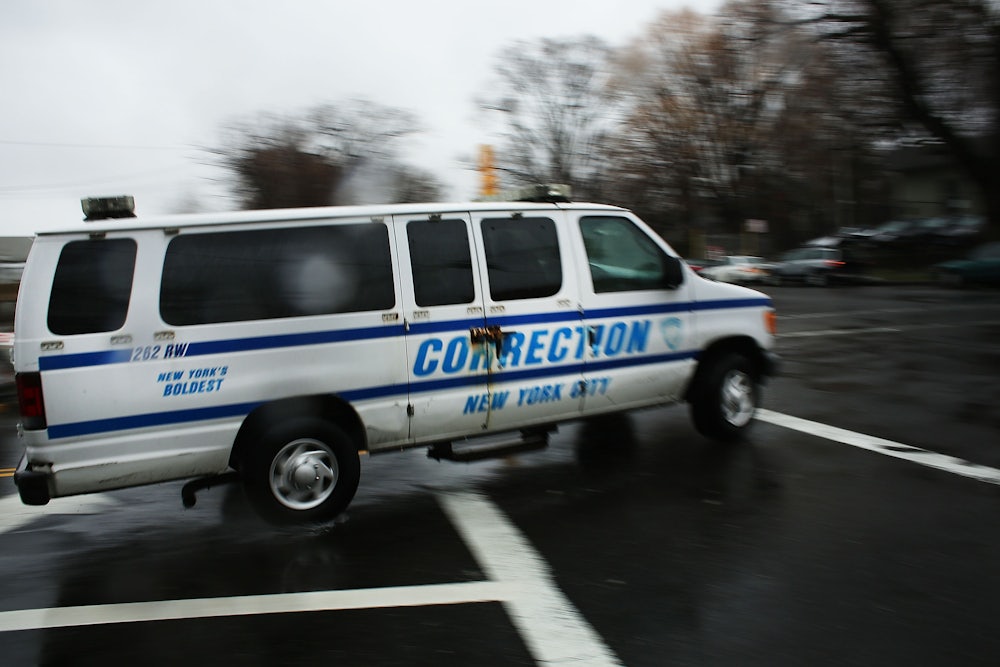On Monday evening, New York City Mayor Bill de Blasio glad-handed with some of the city’s wealthiest at the Met Gala, ignoring the activists gathered outside the museum calling for him to defund the New York Police Department. Shortly thereafter, the protesters were arrested by NYPD officers. Just a few miles away was the site of another related crisis the mayor had been largely ignoring—the increasingly brutal conditions at Rikers Island, the city’s notoriously hellish jail complex that has, during the pandemic, become even more hellish.
Earlier that day, a group of elected and soon-to-be-elected officials visited the jail and sounded the alarm over what they had seen. “For seven hours on Monday, I bore witness to the deadly conditions on Rikers Island. What I saw is beyond anything I experienced as a public defender,” Tiffany Cabán, now a candidate for city council, wrote in an op-ed. She continued: “Intake cells, where folks should only spend their first 24 hours, are dangerously overcrowded, with people waiting up to seven or eight days without access to attorneys or medical care.”
New York State Assembly member Emily Gallagher also described her Monday visit to the Otis Bantum Correctional Center on Rikers Island, writing that she saw “garbage everywhere, rotting food with maggots, cockroaches, worms in the showers, human feces and piss.” Gallagher described what amounts to torture. “I was told by many people being held there that they’re given a single meal a day, and even that has to be demanded and begged for. Everyone was thirsty and had limited access to water,” she wrote. She added, “There’s a lot of serious mental illness, and many hadn’t been given their prescription medication for months. I met multiple men with broken hands and legs that were not being treated.”
Ten people held at Rikers Island have died over the past year, with at least four of those deaths resulting from suicide. In June, 60-year-old Hector Rodriguez died at Rikers from an asthma attack. Rodriguez, who had been convicted of rape as a teen and subsequently spent more than two decades in prison, and in recent years was homeless, had ended up at Rikers after missing several court dates and failing to, as The City wrote, “report to authorities every 90 days” and verify his address. (One wonders what an unhoused man would use as his address.) The latest death, of 24-year-old Esias Johnson, came earlier this month. Johnson had been detained on Rikers for a month, after being arrested for a misdemeanor, which led to police learning he had a separate misdemeanor warrant. His bail had been set at $1, but according to his family, corrections officers had failed to take him to all of his court dates, lengthening his stay at Rikers—a growing problem for people held at the jail. Before his death, Johnson had been experiencing stomach pains, according to reporting by The New York Times, and asked repeatedly for medical attention, which he didn’t receive due to a backlog of patients; he was found dead by another man held at the jail shortly afterward.
Rikers has long been a site of human suffering; the plan for its eventual closure, passed in 2019, is a belated recognition of its long-standing failures. (In 2015, for instance, an independent federal monitor was appointed to oversee reforms at the jail after a lawsuit charged that guards were systematically brutalizing people held there.) Rikers, if all goes smoothly for the city, will be replaced, at an astonishing cost of $8 billion, by smaller, borough-based jails, which are promised to be more humane—just as Rikers itself, when it was built, was supposedly going to be a modern, more humane replacement for a previous city jail. But growing prison abolitionist activism has made decarceration a viable solution now for the deepening crisis at Rikers.
The pandemic offered a roadmap: Last year, the city dramatically reduced the numbers of people held at Rikers in response to Covid-19, a push mirrored in local jails around the country. In New York, the call for decarceration has been forceful, coming not only from critics of mass incarceration but from the self-identified socialists recently elected to office or who, like Cabán, have won their primaries for upcoming elections. “There is a way to end this crisis: Release people from jail,” Cabán wrote in her op-ed, noting sensible and immediate steps that district attorneys, de Blasio, and Governor Kathy Hochul could take. She added, “The only thing stopping those in power is political will.”
That lack of political will is evident in Mayor de Blasio’s belated and insufficient plan to address the current situation, which focuses on shoring up the existing system and framing the dangerous and inhumane conditions in large part as a staffing issue; specifically, a lack of staff. But the fact that thousands of correctional officers have, for several months, been simply refusing to show up for work each day is merely a smokescreen, albeit one that both the mayor and the correctional officers’ union, the Correction Officers’ Benevolent Association, or COBA, have run with.
There is a staffing issue—but it’s not that Rikers is understaffed. In fact, the opposite is true, even with the extraordinarily high numbers of officers who are calling in sick every day. As the federal monitor wrote in his May report, “Notwithstanding the abnormally high absenteeism, the Department still has an extraordinarily large number of Staff to operate the jails,” one that is “highly unusual” and “one of the richest staffing ratios among the systems with which the Monitoring Team has had experience.” The real staffing problems are, as the monitor noted, a misuse of those employees and a culture of abuse and impunity among them that has “developed over decades.”
Correctional officers’ unions have received relatively scant attention when compared to their police brethren’s role in maintaining our carceral state, but that should change, given their role in shielding officers from accountability and in promoting tough-on-crime narratives. (The roles are similar enough that many correctional officers end up joining the NYPD.) COBA, which boasts at the top of its website that its members are “PATROLLING THE TOUGHEST PRECINCTS IN NEW YORK,” has framed the humanitarian crisis at Rikers as a workers’ rights issue, its president, Benny Boscio, going so far as to describe conditions for officers as “modern-day slavery,” during a City Council hearing on Wednesday. But COBA’s “solution” is to prop up its already bloated numbers, pushing for the hiring of 2,000 additional corrections officers. This demand is akin to police unions arguing that public safety is best served by hiring more cops, a transparent move to consolidate their power and authority.
Around the country, in cities like Philadelphia, St. Louis, and Louisville, Kentucky, jail woes have been blamed on understaffing. No doubt it’s unpleasant to work in a system that warehouses people in dehumanizing, unsanitary, and dangerous conditions. But adding more staff won’t change the problems underlying those conditions. When it comes to Rikers, the way to ensure safety and dignity for all those caught up in a dehumanizing system is to remove them from that system. Let them go.








